Comparative testing of 32 GB SDHC memory cards of UHS-I standard
Buying almost any modern device, be it a smartphone, tablet, video recorder, digital camera or digital video camera automatically entails the acquisition of a memory card. Many manufacturers offer a wide range of cards varying in size, grade, read / write speed and price. And here the user is faced with the agony of choosing the right memory card. Especially if the scope of interest includes shooting video in Full HD format or high-speed continuous shooting with a multi-pixel camera. Having acquired at my disposal 11 different SDHC memory cards of the UHS-I standard with a capacity of 32 GB, I will try to shed light on the alignment of forces and determine the really best memory cards based on the results of synthetic tests and real-world problems.

The writing of this review pushed me to acquire a Nikon D7100 digital SLR camera. Particularly acute was the issue for tasks with serial shooting in RAW (NEF) format. The rate of fire at 6 frames per second and the buffer size of just under 6 frames imposes increased performance requirements on memory cards. And the size of the RAW file of the order of 30 MB makes the situation even worse. However, I’ll leave performance testing at the end of the article, but first I’ll describe the appearance of the cards with their packages.
For testing, I managed to get the following memory cards:
• Kingston SDHC UHS-I U3
• Kingston Ultimate SDHC Class 10 UHS-I
• OltraMax OM032GSDHC10 SDHC Class 10 UHS-I
• SanDisk Extreme Pro SDHC Class 10 UHS-I
• SanDisk Extreme SDHC Class 10 UHS-I
• Silicon Power Superior SDHC Class 10 UHS-I
• Sony SDHC Class 10 UHS-I
• Toshiba Exceria Type 2 SDHC Class 10 UHS-I
• Toshiba SDHC Class 10 UHS-I
• Transcend Ultimate SDHC Class 10 UHS-I
• Transcend Premium SDHC Class 10 UHS-I
In the descriptive part, the alignment of cards is strictly alphabetical, without a hint of their cost or binding to the vendor.
')
Kingston SDHC UHS-I U3

The memory card is packed in a simple blister. In the color design used maroon colors. The stated speeds for read and write operations are 90 MB / s and 80 MB / s, respectively.
This card is an absolute novelty of the Kingston company and got into a comparative review at the last moment. The manufacturer orients its use for recording and playback of 4K2K video.
After the sale, this card will be the highest in the line of SDHC cards from Kingston.
The code designation is SDA3 / 32GB.
Technical description on the manufacturer's website - www.kingston.com/ru/flash/sd_cards#sda3
Kingston Ultimate SDHC Class 10 UHS-I
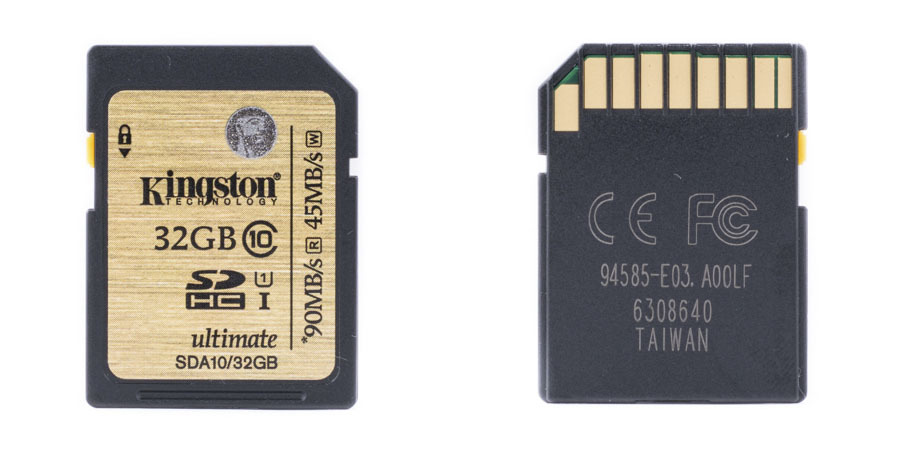
Exactly, like the previous card from Kingston, this card is packaged in a thin blister. Color design is made in a bright and catchy style. The combination of black and red and black and gold is often used in the design of boxes of premium computer components. The manufacturer claims speeds of up to 90 MB / s for read operations and up to 45 MB / s for write operations.
The code designation is SDA10 / 32GB.
Technical description on the manufacturer's website - www.kingston.com/ru/flash/sd_cards#sda10
OltraMax OM032GSDHC10 SDHC Class 10 UHS-I
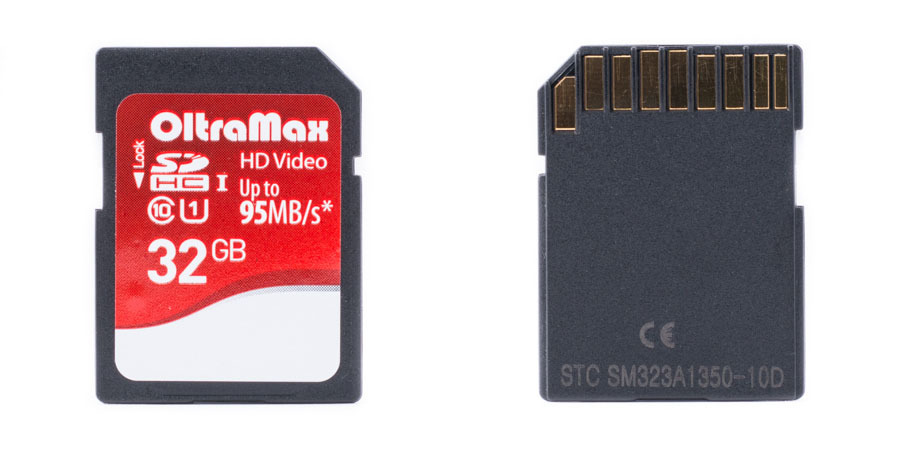
OltraMax OM032GSDHC10 memory card has the most modest packaging. A simple blister with an indication of the type of card and the claimed speed of up to 95 MB / s. The manufacturer did not separately write speeds for read and write operations. Therefore, looking ahead, I will say that this statement is valid only for reading and is in no way applicable to the record.
The code designation is OM032GSDHC10.
SanDisk Extreme Pro SDHC Class 10 UHS-I
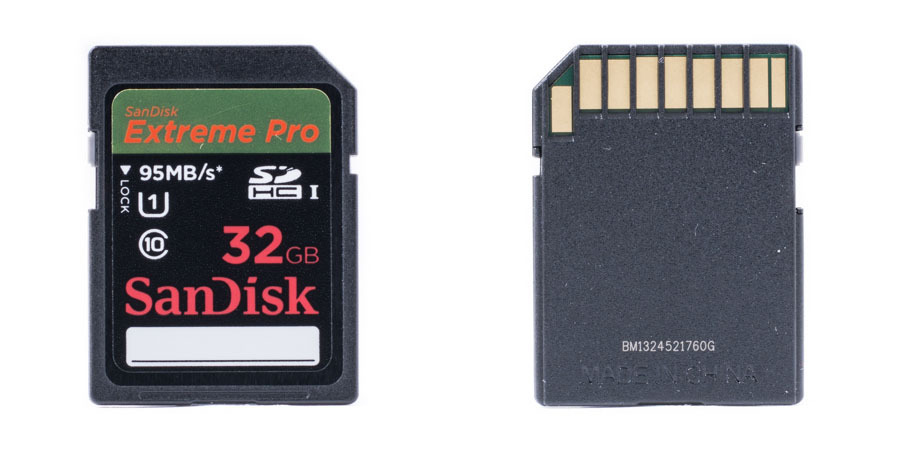
SanDisk Extreme Pro memory card is packed in a cardboard box. The side walls of which contain a lot of useful information about the speed characteristics, various options for card protection, as well as the manufacturer's statement that it is the world's number one memory card supplier. The speed declared by the manufacturer is up to 95 MB / s, without decoding for which operations.
Unlike previous review heroes, a plastic box is attached to the memory card for easy storage and transportation.
At the time of writing, this card was the highest in the SDHC line of cards in the SanDisk line of memory cards.
The code designation is SDSDXPA-032G-X46.
Technical description on the manufacturer's website - ru.sandisk.com/products/memory-cards/sd/extremepro-sdxc-sdhc-uhs-1-95mbs/?capacity=32GB
SanDisk Extreme SDHC Class 10 UHS-I

SanDisk's next memory card is Extreme. It is packed in a box decorated absolutely identical to the box from the highest card. True, this time the claimed speed is 45 MB / s.
A plastic box is also included in the kit, which will be a clear help if it is stored or transported if you have several memory cards.
The code designation is SDSDX-032G-X46.
Technical description on the manufacturer's website - ru.sandisk.com/products/memory-cards/sd/extreme-uhs-1-45mbs/?capacity=32GB
Silicon Power Superior SDHC Class 10 UHS-I
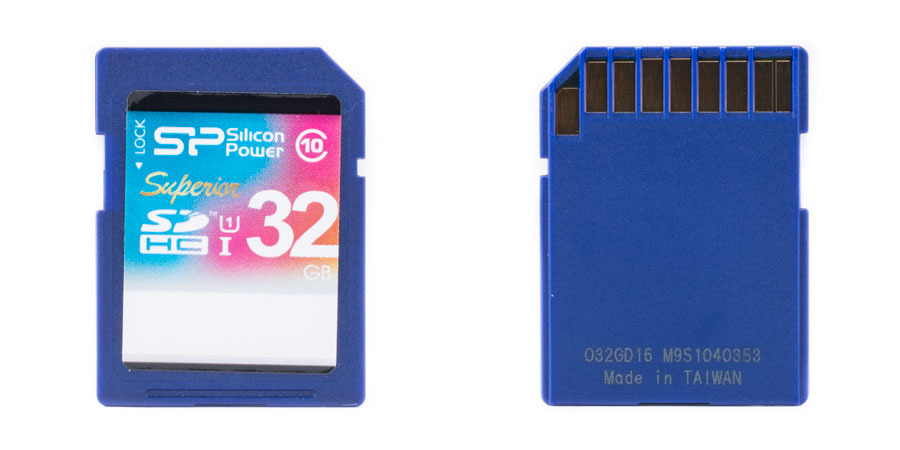
Silicon Power Superior memory card is packed in a simple blister. The fine print on the reverse side of the package claims a speed of up to 90 MB / s for read operations and up to 45 MB / s for writing.
The code designation is SP032GBSDHCU1V10.
Technical description on the manufacturer's website - www.silicon-power.com/product/product_detail.php?main=1&sub=45&pro=143&currlang=koi8r
Sony SDHC Class 10 UHS-I
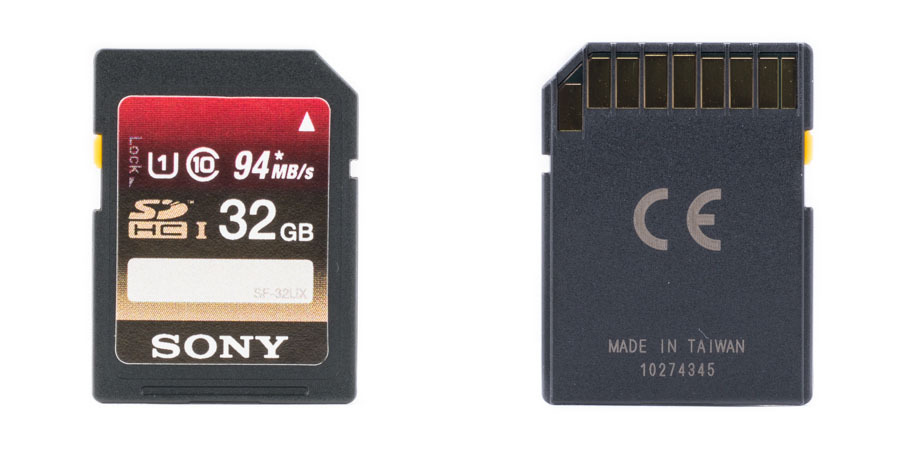
Sony SF32UX memory card is packed in a standard blister. The manufacturer claims maximum speeds for read operations up to 94 MB / s.
Code designation - SF32UX.
Technical description on the manufacturer's website - www.sony.com.au/product/sf-32ux
Toshiba Exceria Type 2 SDHC Class 10 UHS-I

Toshiba products are represented by two memory cards. The first Toshiba Exceria Type 2 is packed in a cardboard box. The manufacturer claims speeds of up to 95 BM / s for read operations and up to 60 MB / s for write operations.
Included with the memory card is a plastic box for storage.
The code designation is SD-X32T2.
Technical description on the manufacturer's website - www.toshiba-memory.com/cms/ru/produktsiya/karty_pamiaty_sd/exceria/exceria-type-2.html
Toshiba SDHC Class 10 UHS-I
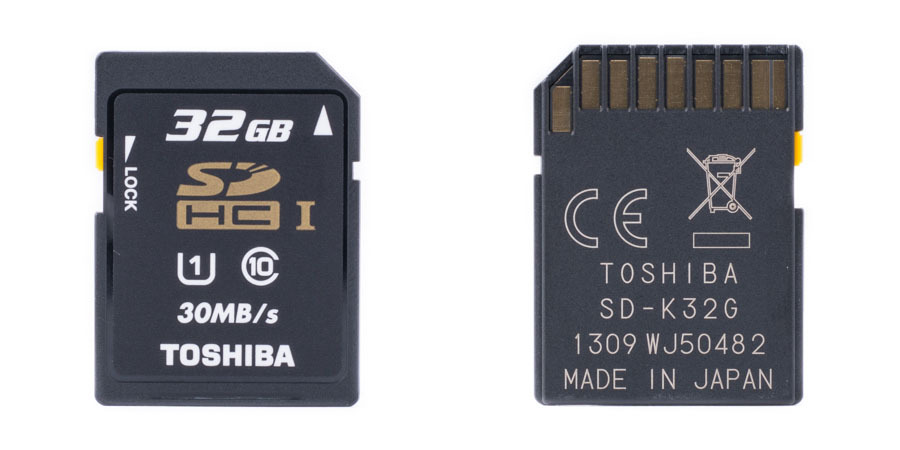
Toshiba's second memory card is the SD-T032UHS1. This time it is packed in a thin blister. In addition, the kit is missing a box for a memory card. Speed characteristics are listed directly on the memory card. The manufacturer claims speeds of up to 30 MB / s, without specifying the type of data operations.
The code designation is SD-T032UHS1.
Technical description on the manufacturer's website - www.toshiba-memory.com/cms/ru/produktsiya/karty_pamiaty_sd/hs-professional/sdhc-high-speed-professional-uhs1.html
Transcend Ultimate SDHC Class 10 UHS-I
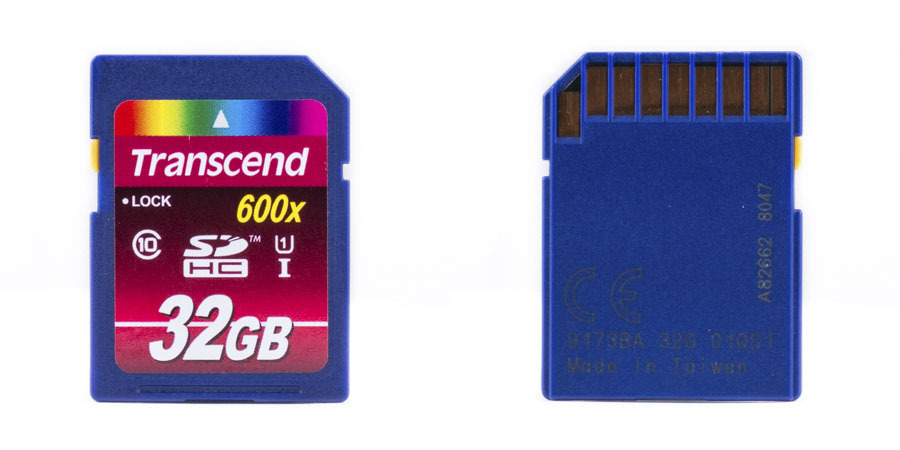
The Transcend company is also represented by two memory cards. The first card is the highest in the Transcend Ultimate lineup. It is packed in a blister. The manufacturer claims speeds up to 85 MB / s, without specifying the type of operations.
Transcend products have a rather convenient color marking. The top Transcend Ultimate card has a red sticker when the next Transcend Premium is blue. It is very convenient if you have several memory cards from this manufacturer, and at the moment you need a specific card.
The code designation is TS32GSDHC10U1.
Technical description on the manufacturer's website - www.transcend-info.com/products/Catlist.asp?modno=367&cat_no=185
Transcend Premium SDHC Class 10 UHS-I
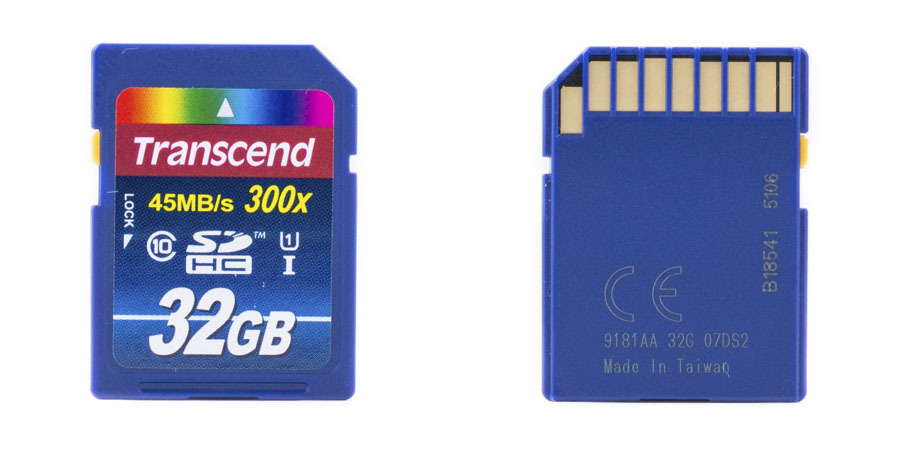
The Transcend Premium memory card, exactly like the Transcend Ultimate, is packaged in an ordinary blister. At this time, the manufacturer claims speeds of up to 45 MB / s, also without specifying the type of operations.
The code designation is TS32GSDU1.
Technical description on the manufacturer's website - www.transcend-info.com/products/Catlist.asp?modno=415&cat_no=185
For the convenience of perception of this information, I have combined the name of the memory cards, their codes, the country of production and the presence of a plastic box in a set in a single table.
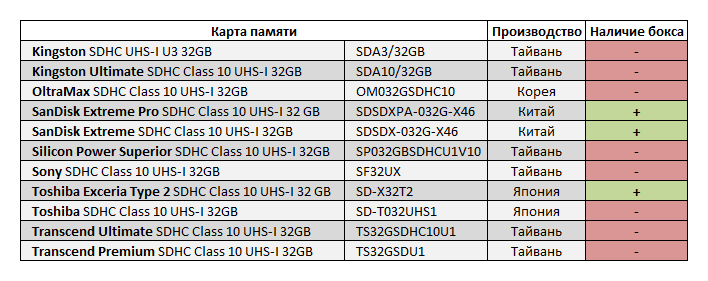
Based on my personal experience, I assumed in advance that, despite the size of 32 GB cards declared by the manufacturers, the available volume of different cards will differ somewhat. Therefore, I formatted all the memory cards in a Nikon D7100 camera. I determined the available volume through the disk properties and using the AIDA64 test package.
All the information received was also summarized in a single table. Cells with data below the average were colored red, and cells with data above the average were colored green. Maximum and minimum values are additionally highlighted in bold. This design will be valid for all the following tables.
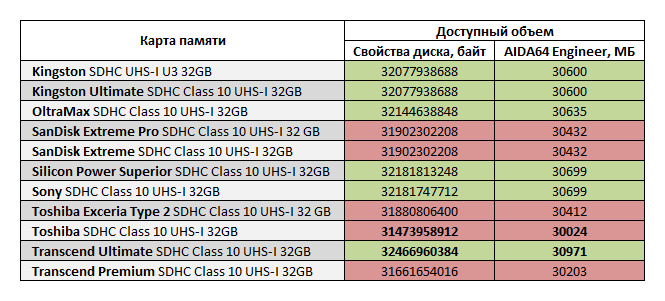
The Transcend Ultimate memory card provides the most available space, while the Toshiba SD-T032UHS1 card is the least accessible. The difference is 947 MB, which in relative equivalent is about 3% of the available capacity. By the standards of RAW photos, for example, from my Nikon D7100 camera, this corresponds to a little more than 30 pictures of the maximum quality. Agree, it is not very pleasant to lose a similar amount when buying cards of one declared volume.
To study the speed characteristics of memory cards I used the following test packets:
• AIDA64 Engineer Edition
• ATTO Disk Benchmark
• CrystalDiskMark
Testing was carried out in the Transcend TS-RDF8K card reader connected to the USB 3.0 port of the ASUS Maximus V Gene motherboard.
Crystaldiskmark
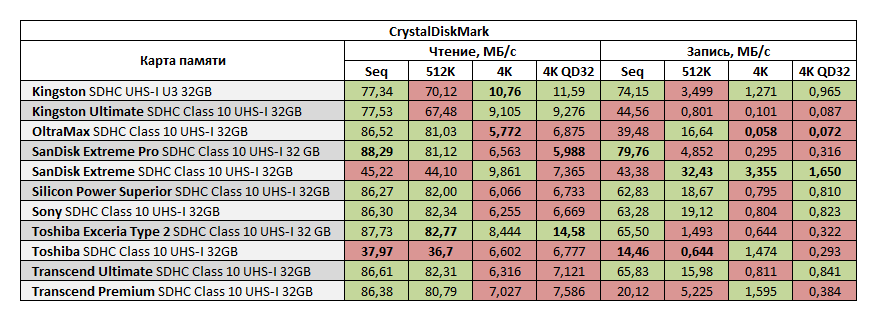
The sequential reading test splits the cards into two categories. The first with read speeds of about 90 MB / s, the second with less than 50 MB / s. Inside the first category, you can separately select memory cards from Kingston, which demonstrated the lowest speeds in the group, namely ~ 77 MB / s.
Why two categories? The thing is that despite the specification of UHS-I with a maximum data transfer rate of up to 104 MB / s, there are two standards SDR50 and SDR104. Accordingly, the maximum interface data transfer rate for the SDR50 is 50 MB / s, while for the SDR104 it is 104 MB / s. Therefore, SanDisk Extreme and Toshiba SD-T032UHS1 memory cards are related to UHS-I SDR50, when all others are to UHS-I SDR104.
The test results for sequential recording can also be divided into two categories. However, most cards with high read speeds, such as Kingston SDA3, SanDisk Extreme Pro, Silicon Power Superior, Sony SF32UX, Toshiba Exceria Type 2 and Transcend Ultimate, demonstrated high write speeds. Whereas the Kingston Ultimate cards, OltraMax OM032GSDHC10 and Transcend Premium, the sequential speeds for which were significantly lower than the speeds of reading, flew from the leading group to the second.
Those memory cards that showed mediocre results for read operations, in the test for sequential write could not surprise anything.
The clear leader in the CrystalDiskMark test results was the SanDisk Extreme Pro card, and the Toshiba SD-T032UHS1 outsider.
ATTO Disk Benchmark, reading (clickable)
Testing was performed with a minimum task size of 256 MB, in blocks from 0.5 to 8192 KB.

The alignment of forces is fully consistent with the previously obtained results in the CrystalDiskMark test. In this case, the test allows you to assess how well or poorly memory cards cope with operations for small and large files.
It is noteworthy that the two cards (SanDisk Extreme Pro and Toshiba Exceria Type 2) were able to demonstrate results above average, regardless of the size of the data block. At the same time, Toshiba Exceria Type 2 works better with small files, when SanDisk Extreme Pro takes the lead after marking 32 KB. To work with multimedia files, of course, the optimization of the card for working with large files is of greater importance.
ATTO Disk Benchmark, record (clickable)

In the test results for the record, not a single card can show results higher than the rest, regardless of the data block. Although the Kingston SDA3 was close to this like no other. In this test, you can mark cards Kingston SDA3 and SanDisk Extreme Pro for achieving maximum results. The Silicon Power Superior, Sony SF32UX, Toshiba Exceria Type 2 and Transcend Ultimate cards go a little further, and Kingston Ultimate, OltraMax OM032GSDHC10, SanDisk Extreme, Toshiba SD-T032UHS1 and Transcend Premium are the close ones.
AIDA64 Engineer Edition , linear read and write

The results of AIDA64 Engineer Edition for linear reading and writing once again confirm the previously obtained results in other tests. Therefore, I will not dwell on their description. I will only note that for test leaders, speeds for write operations are almost identical to speeds for read operations.
AIDA64 Engineer Edition , random read and write
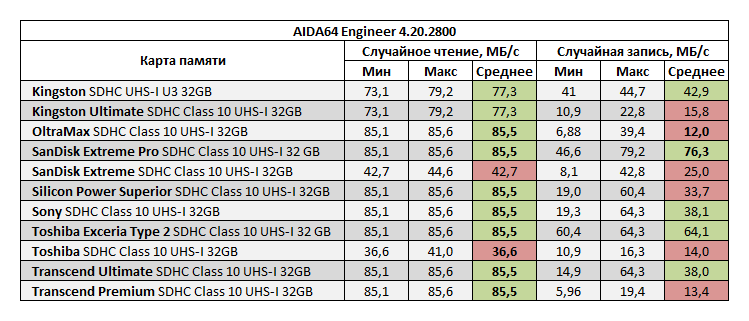
But testing for random reading and writing again changes the balance of forces somewhat. The only cards whose write results are comparable to the reading are SanDisk Extreme Pro and Toshiba Exceria Type 2. While the rest of the leaders, the random write speed has almost halved compared to sequential write. Of course, random recording is not such an important characteristic for memory cards as sequential recording, but I couldn’t help but note this fact.
AIDA64 Engineer Edition , access time

Access time is also not the primary feature for memory cards. However, for a number of tasks, it can play a crucial role. Therefore, I decided to do testing on this parameter.
If the random access time for reading is approximately comparable for all cards. The random access time for recording differs much more, and the difference between the best card and the worst one is almost 10 times.
In order not to be limited to synthetic tests, I compared the two cards for the possibility of high-speed shooting in a Nikon D7100 camera. For this, the following settings were made:
• Ch shooting mode (6 frames per second);
• shooting only in RAW;
• 14-bit RAW;
• shutter speed 1/2000 second;
• f / 2.8 aperture;
• ISO 100;
• D-Lighting off;
• control of distortion off;
• noise suppression off;
• series duration is 30 seconds.
A series of 30 seconds was set using the YONGNUO MC-36R remote control. To avoid measurement errors, three measurements were made with further averaging of the result and its rounding up to a whole number. The size of the received files with RAW photos was 29.8 MB.
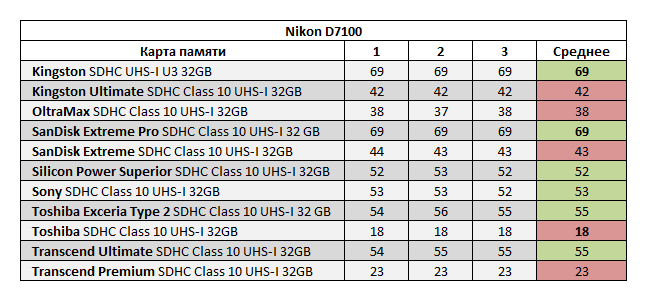
The test results with a camera revealed four groups among the memory cards.
The first group is a group of undoubted leaders, which include two memory cards: Kingston SDA3 and SanDisk Extreme Pro. Both cards showed the same result, managing to record 69 frames in 30 seconds.
The second group was formed by strong middle peasants. It hit Silicon Power Superior, Sony SF32UX, Toshiba Exceria Type 2 and Transcend Ultimate.
Kingston Ultimate memory cards, OltraMax OM032GSDHC10 and SanDisk Extreme formed the third group, whose results are below average.
Well, to the outsiders of this test are two memory cards Toshiba SD-T032UHS1 and Transcend Premium, showing just the sad results for this task.
And finally, the financial side of the issue.
The approximate cost of memory cards today:
• Kingston SDHC UHS-I U3 32GB - 2,200 rubles.
• Kingston Ultimate SDHC Class 10 UHS-I 32GB - 1,450 rubles.
• OltraMax OM032GSDHC10 SDHC Class 10 UHS-I 32GB - 1,250 rubles.
• SanDisk Extreme Pro SDHC Class 10 UHS-I 32GB - 2,700 rubles.
• SanDisk Extreme SDHC Class 10 UHS-I 32GB - 1,800 rubles.
• Silicon Power Superior SDHC Class 10 UHS-I 32GB - 1,400 rubles.
• Sony SDHC Class 10 UHS-I 32GB - 1450 rubles
• Toshiba Exceria Type 2 SDHC Class 10 UHS-I 32GB - 1,500 rubles.
• Toshiba SDHC Class 10 UHS-I 32GB - 900 rubles.
• Transcend Ultimate SDHC Class 10 UHS-I 32GB - 1,400 rubles.
• Transcend Premium SDHC Class 10 UHS-I 32GB - 1,150 rubles.
If you need maximum performance from a memory card and your budget for its acquisition is not limited in any way, then undoubtedly the best choice will be - SanDisk Extreme Pro.
The novelty from the Kingston company allows, at very close performance with the SanDisk Extreme Pro card, to save about 500 rubles. Kingston SDA3 is somewhat inferior except for reading operations. At the same time, the test for recording in a Nikon D7100 camera showed absolutely identical results with the leader.
Next comes an extensive group, which not only showed equal results, but the difference in cost for these cards ranges from 100 rubles. Silicon Power Superior, Sony SF32UX, Toshiba Exceria Type 2 and Transcend Ultimate will be the best choice for users who are not so keen on recording speed. Not every amateur photographer is keen on high-speed shooting. With a slight lag in performance from the leader, buying these cards will save the budget almost twice. For example, instead of a single SanDisk Extreme Pro card, you can buy a couple of such cards and get the highest reliability of image safety, in case of failure of one of their memory cards.
Next come Kingston Ultimate and OltraMax OM032GSDHC10 memory cards. At comparable cost with previous cards, they demonstrate lower write speeds.
SanDisk Extreme memory card costs about 1,800 rubles. If its results for write operations are still comparable to the Kingston Ultimate and OltraMax OM032GSDHC10 cards, then the reading is almost twice as low. At the same time, Kingston Ultimate and OltraMax OM032GSDHC10 cost 1450 and 1250 rubles, respectively. In my opinion, the cost of the SanDisk Extreme card is not at all true.
Well, this list closes the Toshiba SD-T032UHS1 and Transcend Premium memory card. Modest performance for modest money.

The writing of this review pushed me to acquire a Nikon D7100 digital SLR camera. Particularly acute was the issue for tasks with serial shooting in RAW (NEF) format. The rate of fire at 6 frames per second and the buffer size of just under 6 frames imposes increased performance requirements on memory cards. And the size of the RAW file of the order of 30 MB makes the situation even worse. However, I’ll leave performance testing at the end of the article, but first I’ll describe the appearance of the cards with their packages.
For testing, I managed to get the following memory cards:
• Kingston SDHC UHS-I U3
• Kingston Ultimate SDHC Class 10 UHS-I
• OltraMax OM032GSDHC10 SDHC Class 10 UHS-I
• SanDisk Extreme Pro SDHC Class 10 UHS-I
• SanDisk Extreme SDHC Class 10 UHS-I
• Silicon Power Superior SDHC Class 10 UHS-I
• Sony SDHC Class 10 UHS-I
• Toshiba Exceria Type 2 SDHC Class 10 UHS-I
• Toshiba SDHC Class 10 UHS-I
• Transcend Ultimate SDHC Class 10 UHS-I
• Transcend Premium SDHC Class 10 UHS-I
In the descriptive part, the alignment of cards is strictly alphabetical, without a hint of their cost or binding to the vendor.
')
Kingston SDHC UHS-I U3

The memory card is packed in a simple blister. In the color design used maroon colors. The stated speeds for read and write operations are 90 MB / s and 80 MB / s, respectively.
This card is an absolute novelty of the Kingston company and got into a comparative review at the last moment. The manufacturer orients its use for recording and playback of 4K2K video.
After the sale, this card will be the highest in the line of SDHC cards from Kingston.
The code designation is SDA3 / 32GB.
Technical description on the manufacturer's website - www.kingston.com/ru/flash/sd_cards#sda3
Kingston Ultimate SDHC Class 10 UHS-I

Exactly, like the previous card from Kingston, this card is packaged in a thin blister. Color design is made in a bright and catchy style. The combination of black and red and black and gold is often used in the design of boxes of premium computer components. The manufacturer claims speeds of up to 90 MB / s for read operations and up to 45 MB / s for write operations.
The code designation is SDA10 / 32GB.
Technical description on the manufacturer's website - www.kingston.com/ru/flash/sd_cards#sda10
OltraMax OM032GSDHC10 SDHC Class 10 UHS-I

OltraMax OM032GSDHC10 memory card has the most modest packaging. A simple blister with an indication of the type of card and the claimed speed of up to 95 MB / s. The manufacturer did not separately write speeds for read and write operations. Therefore, looking ahead, I will say that this statement is valid only for reading and is in no way applicable to the record.
The code designation is OM032GSDHC10.
SanDisk Extreme Pro SDHC Class 10 UHS-I

SanDisk Extreme Pro memory card is packed in a cardboard box. The side walls of which contain a lot of useful information about the speed characteristics, various options for card protection, as well as the manufacturer's statement that it is the world's number one memory card supplier. The speed declared by the manufacturer is up to 95 MB / s, without decoding for which operations.
Unlike previous review heroes, a plastic box is attached to the memory card for easy storage and transportation.
At the time of writing, this card was the highest in the SDHC line of cards in the SanDisk line of memory cards.
The code designation is SDSDXPA-032G-X46.
Technical description on the manufacturer's website - ru.sandisk.com/products/memory-cards/sd/extremepro-sdxc-sdhc-uhs-1-95mbs/?capacity=32GB
SanDisk Extreme SDHC Class 10 UHS-I

SanDisk's next memory card is Extreme. It is packed in a box decorated absolutely identical to the box from the highest card. True, this time the claimed speed is 45 MB / s.
A plastic box is also included in the kit, which will be a clear help if it is stored or transported if you have several memory cards.
The code designation is SDSDX-032G-X46.
Technical description on the manufacturer's website - ru.sandisk.com/products/memory-cards/sd/extreme-uhs-1-45mbs/?capacity=32GB
Silicon Power Superior SDHC Class 10 UHS-I

Silicon Power Superior memory card is packed in a simple blister. The fine print on the reverse side of the package claims a speed of up to 90 MB / s for read operations and up to 45 MB / s for writing.
The code designation is SP032GBSDHCU1V10.
Technical description on the manufacturer's website - www.silicon-power.com/product/product_detail.php?main=1&sub=45&pro=143&currlang=koi8r
Sony SDHC Class 10 UHS-I

Sony SF32UX memory card is packed in a standard blister. The manufacturer claims maximum speeds for read operations up to 94 MB / s.
Code designation - SF32UX.
Technical description on the manufacturer's website - www.sony.com.au/product/sf-32ux
Toshiba Exceria Type 2 SDHC Class 10 UHS-I

Toshiba products are represented by two memory cards. The first Toshiba Exceria Type 2 is packed in a cardboard box. The manufacturer claims speeds of up to 95 BM / s for read operations and up to 60 MB / s for write operations.
Included with the memory card is a plastic box for storage.
The code designation is SD-X32T2.
Technical description on the manufacturer's website - www.toshiba-memory.com/cms/ru/produktsiya/karty_pamiaty_sd/exceria/exceria-type-2.html
Toshiba SDHC Class 10 UHS-I

Toshiba's second memory card is the SD-T032UHS1. This time it is packed in a thin blister. In addition, the kit is missing a box for a memory card. Speed characteristics are listed directly on the memory card. The manufacturer claims speeds of up to 30 MB / s, without specifying the type of data operations.
The code designation is SD-T032UHS1.
Technical description on the manufacturer's website - www.toshiba-memory.com/cms/ru/produktsiya/karty_pamiaty_sd/hs-professional/sdhc-high-speed-professional-uhs1.html
Transcend Ultimate SDHC Class 10 UHS-I

The Transcend company is also represented by two memory cards. The first card is the highest in the Transcend Ultimate lineup. It is packed in a blister. The manufacturer claims speeds up to 85 MB / s, without specifying the type of operations.
Transcend products have a rather convenient color marking. The top Transcend Ultimate card has a red sticker when the next Transcend Premium is blue. It is very convenient if you have several memory cards from this manufacturer, and at the moment you need a specific card.
The code designation is TS32GSDHC10U1.
Technical description on the manufacturer's website - www.transcend-info.com/products/Catlist.asp?modno=367&cat_no=185
Transcend Premium SDHC Class 10 UHS-I

The Transcend Premium memory card, exactly like the Transcend Ultimate, is packaged in an ordinary blister. At this time, the manufacturer claims speeds of up to 45 MB / s, also without specifying the type of operations.
The code designation is TS32GSDU1.
Technical description on the manufacturer's website - www.transcend-info.com/products/Catlist.asp?modno=415&cat_no=185
For the convenience of perception of this information, I have combined the name of the memory cards, their codes, the country of production and the presence of a plastic box in a set in a single table.

Based on my personal experience, I assumed in advance that, despite the size of 32 GB cards declared by the manufacturers, the available volume of different cards will differ somewhat. Therefore, I formatted all the memory cards in a Nikon D7100 camera. I determined the available volume through the disk properties and using the AIDA64 test package.
All the information received was also summarized in a single table. Cells with data below the average were colored red, and cells with data above the average were colored green. Maximum and minimum values are additionally highlighted in bold. This design will be valid for all the following tables.

The Transcend Ultimate memory card provides the most available space, while the Toshiba SD-T032UHS1 card is the least accessible. The difference is 947 MB, which in relative equivalent is about 3% of the available capacity. By the standards of RAW photos, for example, from my Nikon D7100 camera, this corresponds to a little more than 30 pictures of the maximum quality. Agree, it is not very pleasant to lose a similar amount when buying cards of one declared volume.
To study the speed characteristics of memory cards I used the following test packets:
• AIDA64 Engineer Edition
• ATTO Disk Benchmark
• CrystalDiskMark
Testing was carried out in the Transcend TS-RDF8K card reader connected to the USB 3.0 port of the ASUS Maximus V Gene motherboard.
Crystaldiskmark

The sequential reading test splits the cards into two categories. The first with read speeds of about 90 MB / s, the second with less than 50 MB / s. Inside the first category, you can separately select memory cards from Kingston, which demonstrated the lowest speeds in the group, namely ~ 77 MB / s.
Why two categories? The thing is that despite the specification of UHS-I with a maximum data transfer rate of up to 104 MB / s, there are two standards SDR50 and SDR104. Accordingly, the maximum interface data transfer rate for the SDR50 is 50 MB / s, while for the SDR104 it is 104 MB / s. Therefore, SanDisk Extreme and Toshiba SD-T032UHS1 memory cards are related to UHS-I SDR50, when all others are to UHS-I SDR104.
The test results for sequential recording can also be divided into two categories. However, most cards with high read speeds, such as Kingston SDA3, SanDisk Extreme Pro, Silicon Power Superior, Sony SF32UX, Toshiba Exceria Type 2 and Transcend Ultimate, demonstrated high write speeds. Whereas the Kingston Ultimate cards, OltraMax OM032GSDHC10 and Transcend Premium, the sequential speeds for which were significantly lower than the speeds of reading, flew from the leading group to the second.
Those memory cards that showed mediocre results for read operations, in the test for sequential write could not surprise anything.
The clear leader in the CrystalDiskMark test results was the SanDisk Extreme Pro card, and the Toshiba SD-T032UHS1 outsider.
ATTO Disk Benchmark, reading (clickable)
Testing was performed with a minimum task size of 256 MB, in blocks from 0.5 to 8192 KB.

The alignment of forces is fully consistent with the previously obtained results in the CrystalDiskMark test. In this case, the test allows you to assess how well or poorly memory cards cope with operations for small and large files.
It is noteworthy that the two cards (SanDisk Extreme Pro and Toshiba Exceria Type 2) were able to demonstrate results above average, regardless of the size of the data block. At the same time, Toshiba Exceria Type 2 works better with small files, when SanDisk Extreme Pro takes the lead after marking 32 KB. To work with multimedia files, of course, the optimization of the card for working with large files is of greater importance.
ATTO Disk Benchmark, record (clickable)

In the test results for the record, not a single card can show results higher than the rest, regardless of the data block. Although the Kingston SDA3 was close to this like no other. In this test, you can mark cards Kingston SDA3 and SanDisk Extreme Pro for achieving maximum results. The Silicon Power Superior, Sony SF32UX, Toshiba Exceria Type 2 and Transcend Ultimate cards go a little further, and Kingston Ultimate, OltraMax OM032GSDHC10, SanDisk Extreme, Toshiba SD-T032UHS1 and Transcend Premium are the close ones.
AIDA64 Engineer Edition , linear read and write

The results of AIDA64 Engineer Edition for linear reading and writing once again confirm the previously obtained results in other tests. Therefore, I will not dwell on their description. I will only note that for test leaders, speeds for write operations are almost identical to speeds for read operations.
AIDA64 Engineer Edition , random read and write

But testing for random reading and writing again changes the balance of forces somewhat. The only cards whose write results are comparable to the reading are SanDisk Extreme Pro and Toshiba Exceria Type 2. While the rest of the leaders, the random write speed has almost halved compared to sequential write. Of course, random recording is not such an important characteristic for memory cards as sequential recording, but I couldn’t help but note this fact.
AIDA64 Engineer Edition , access time

Access time is also not the primary feature for memory cards. However, for a number of tasks, it can play a crucial role. Therefore, I decided to do testing on this parameter.
If the random access time for reading is approximately comparable for all cards. The random access time for recording differs much more, and the difference between the best card and the worst one is almost 10 times.
In order not to be limited to synthetic tests, I compared the two cards for the possibility of high-speed shooting in a Nikon D7100 camera. For this, the following settings were made:
• Ch shooting mode (6 frames per second);
• shooting only in RAW;
• 14-bit RAW;
• shutter speed 1/2000 second;
• f / 2.8 aperture;
• ISO 100;
• D-Lighting off;
• control of distortion off;
• noise suppression off;
• series duration is 30 seconds.
A series of 30 seconds was set using the YONGNUO MC-36R remote control. To avoid measurement errors, three measurements were made with further averaging of the result and its rounding up to a whole number. The size of the received files with RAW photos was 29.8 MB.

The test results with a camera revealed four groups among the memory cards.
The first group is a group of undoubted leaders, which include two memory cards: Kingston SDA3 and SanDisk Extreme Pro. Both cards showed the same result, managing to record 69 frames in 30 seconds.
The second group was formed by strong middle peasants. It hit Silicon Power Superior, Sony SF32UX, Toshiba Exceria Type 2 and Transcend Ultimate.
Kingston Ultimate memory cards, OltraMax OM032GSDHC10 and SanDisk Extreme formed the third group, whose results are below average.
Well, to the outsiders of this test are two memory cards Toshiba SD-T032UHS1 and Transcend Premium, showing just the sad results for this task.
And finally, the financial side of the issue.
The approximate cost of memory cards today:
• Kingston SDHC UHS-I U3 32GB - 2,200 rubles.
• Kingston Ultimate SDHC Class 10 UHS-I 32GB - 1,450 rubles.
• OltraMax OM032GSDHC10 SDHC Class 10 UHS-I 32GB - 1,250 rubles.
• SanDisk Extreme Pro SDHC Class 10 UHS-I 32GB - 2,700 rubles.
• SanDisk Extreme SDHC Class 10 UHS-I 32GB - 1,800 rubles.
• Silicon Power Superior SDHC Class 10 UHS-I 32GB - 1,400 rubles.
• Sony SDHC Class 10 UHS-I 32GB - 1450 rubles
• Toshiba Exceria Type 2 SDHC Class 10 UHS-I 32GB - 1,500 rubles.
• Toshiba SDHC Class 10 UHS-I 32GB - 900 rubles.
• Transcend Ultimate SDHC Class 10 UHS-I 32GB - 1,400 rubles.
• Transcend Premium SDHC Class 10 UHS-I 32GB - 1,150 rubles.
If you need maximum performance from a memory card and your budget for its acquisition is not limited in any way, then undoubtedly the best choice will be - SanDisk Extreme Pro.
The novelty from the Kingston company allows, at very close performance with the SanDisk Extreme Pro card, to save about 500 rubles. Kingston SDA3 is somewhat inferior except for reading operations. At the same time, the test for recording in a Nikon D7100 camera showed absolutely identical results with the leader.
Next comes an extensive group, which not only showed equal results, but the difference in cost for these cards ranges from 100 rubles. Silicon Power Superior, Sony SF32UX, Toshiba Exceria Type 2 and Transcend Ultimate will be the best choice for users who are not so keen on recording speed. Not every amateur photographer is keen on high-speed shooting. With a slight lag in performance from the leader, buying these cards will save the budget almost twice. For example, instead of a single SanDisk Extreme Pro card, you can buy a couple of such cards and get the highest reliability of image safety, in case of failure of one of their memory cards.
Next come Kingston Ultimate and OltraMax OM032GSDHC10 memory cards. At comparable cost with previous cards, they demonstrate lower write speeds.
SanDisk Extreme memory card costs about 1,800 rubles. If its results for write operations are still comparable to the Kingston Ultimate and OltraMax OM032GSDHC10 cards, then the reading is almost twice as low. At the same time, Kingston Ultimate and OltraMax OM032GSDHC10 cost 1450 and 1250 rubles, respectively. In my opinion, the cost of the SanDisk Extreme card is not at all true.
Well, this list closes the Toshiba SD-T032UHS1 and Transcend Premium memory card. Modest performance for modest money.
Source: https://habr.com/ru/post/217525/
All Articles